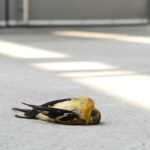Fruit flies, those tiny, bothersome insects often seen buzzing around ripe fruits and vegetables, are a common nuisance in homes and businesses alike. While they might seem to appear out of nowhere, understanding their life cycle and lifespan can provide valuable insights into effective prevention and control strategies. This article delves into the lifespan of a fruit fly, exploring each stage of its development and the factors that influence how long these insects live.
Identifying Fruit Flies
Before diving into their lifespan, it’s helpful to correctly identify fruit flies. They are typically small, ranging from 2.5 to 4 millimeters in length, and are characterized by their tan or yellowish-brown color and distinct bright red eyes. Their antennae have three segments, with the third segment featuring a feathery bristle, which is a key identifier.
The Four Stages of a Fruit Fly Life Cycle
The fruit fly life cycle is relatively short and consists of four distinct stages: egg, larva, pupa, and adult. This rapid life cycle is a key factor in their ability to quickly infest environments with suitable food sources.
Egg Stage
The life of a fruit fly begins as an egg. Female fruit flies are prolific breeders, capable of laying around 500 eggs in their lifetime, often depositing them in batches of approximately 50 at a time. These eggs are typically laid on the surface of fermenting fruits or other decaying organic matter, providing a readily available food source for the larvae once they hatch. Under favorable conditions, which include warmth and humidity, fruit fly eggs hatch remarkably quickly, usually within just 24 hours.
Larva Stage
Once hatched, the fruit fly enters the larva stage. These tiny, maggot-like larvae are the feeding stage of the life cycle. They burrow into the decaying fruit or organic matter, feeding voraciously on the yeasts and microorganisms present. The larval stage is crucial for growth and development. Fruit fly larvae go through three developmental phases called instars. This entire larval development typically lasts for about 5 days, during which they molt and increase in size.
Pupa Stage
After the larval stage, the fruit fly progresses to the pupa stage. The larva finds a dry spot, often away from the food source, and forms a hard, protective casing around itself. Inside this pupal case, metamorphosis occurs. This is a transformative stage where the larval tissues break down and reorganize into the adult form. The pupa stage is non-feeding and usually lasts for around 5 days.
Adult Stage: Lifespan and Reproduction
Emerging from the pupal case is the adult fruit fly. This is the final and longest stage of their life cycle. The primary focus of the adult fruit fly is reproduction. Remarkably, female fruit flies can begin to reproduce within just two days of reaching adulthood. The average adult fruit fly lifespan is approximately 40 to 50 days. During this time, females will lay multiple batches of eggs, contributing to the rapid population growth often associated with fruit fly infestations.
Factors Influencing Fruit Fly Lifespan
While the average lifespan is 40 to 50 days, several environmental factors can influence the developmental time and overall lifespan of fruit flies.
- Temperature: Temperature is a significant factor. Warmer temperatures accelerate the fruit fly life cycle. Development from egg to adult can be quicker, and in some cases, warmer temperatures may even slightly extend adult lifespans. Conversely, cooler temperatures prolong larval and pupal development. Extremely cold temperatures can be lethal to adult fruit flies, and inhibit the development of eggs, larvae, and pupae.
- Humidity: Adequate humidity is essential for fruit fly development, particularly for egg hatching and larval survival. Dry environments can hinder their development and reduce lifespan.
- Food Availability: Access to a consistent food source is crucial. Adult fruit flies need to feed to sustain themselves and reproduce. Larvae require decaying organic matter to grow. Limited food availability can shorten lifespan and slow down reproduction rates.
Why Fruit Flies Seem to Appear So Quickly
The rapid life cycle and relatively short lifespan of fruit flies contribute to their ability to quickly infest homes and businesses. Their development from egg to adult can occur in under two weeks under ideal conditions. Combined with the female’s ability to lay hundreds of eggs, a small number of fruit flies can quickly multiply into a large infestation in a short period. This rapid reproduction rate, coupled with their attraction to common household food waste, is why fruit flies can seem to appear suddenly and in large numbers.
Preventing Fruit Fly Infestations: Managing Lifespan Implications
Understanding the fruit fly lifespan highlights the importance of preventative measures. Since their entire life cycle is relatively short, disrupting any stage can effectively control populations. Preventative strategies should focus on eliminating breeding grounds and food sources.
- Reduce Food Sources: Promptly dispose of overripe fruits and vegetables. Store ripe produce in the refrigerator or sealed containers. Regularly clean up spills, especially sugary liquids or fruit juices.
- Maintain Cleanliness: Regularly clean garbage and recycling bins, ensuring they have tight-fitting lids. Rinse out bottles and cans before recycling. Clean drains, sinks, and areas where food waste might accumulate.
- Eliminate Breeding Sites: Clean up spills immediately. Inspect for and clean up any decaying organic matter, such as damp cloths or sponges.
By focusing on sanitation and removing food sources, you can effectively disrupt the fruit fly life cycle and prevent infestations before they start, making use of their relatively short lifespan against them.
Conclusion
The lifespan of a fruit fly, while short at approximately 40 to 50 days for adults, is characterized by a rapid life cycle and high reproductive rate. Understanding these aspects is key to effective fruit fly control. By focusing on preventative measures that eliminate food sources and breeding grounds, homeowners and businesses can leverage the fruit fly’s short lifespan to minimize infestations and maintain a pest-free environment.
